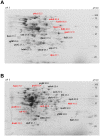Differential actions of chlorhexidine on the cell wall of Bacillus subtilis and Escherichia coli
- PMID: 22606280
- PMCID: PMC3350502
- DOI: 10.1371/journal.pone.0036659
Differential actions of chlorhexidine on the cell wall of Bacillus subtilis and Escherichia coli
Abstract
Chlorhexidine is a chlorinated phenolic disinfectant used commonly in mouthwash for its action against bacteria. However, a comparative study of the action of chlorhexidine on the cell morphology of gram-positive and gram-negative bacteria is lacking. In this study, the actions of chlorhexidine on the cell morphology were identified with the aids of electron microscopy. After exposure to chlorhexidine, numerous spots of indentation on the cell wall were found in both Bacillus subtilis and Escherichia coli. The number of indentation spots increased with time of incubation and increasing chlorhexidine concentration. Interestingly, the dented spots found in B. subtilis appeared mainly at the hemispherical caps of the cells, while in E. coli the dented spots were found all over the cells. After being exposed to chlorhexidine for a prolonged period, leakage of cellular contents and subsequent ghost cells were observed, especially from B subtilis. By using 2-D gel/MS-MS analysis, five proteins related to purine nucleoside interconversion and metabolism were preferentially induced in the cell wall of E. coli, while three proteins related to stress response and four others in amino acid biosynthesis were up-regulated in the cell wall materials of B. subtilis. The localized morphological damages together with the biochemical and protein analysis of the chlorhexidine-treated cells suggest that chlorhexidine may act on the differentially distributed lipids in the cell membranes/wall of B. subtilis and E. coli.
Conflict of interest statement
Figures










References
-
- Sreenivasan PK, Gittins E. The effects of a chlorhexidine mouthrinse on culturable microorganisms of the tongue and saliva. Microbiol Res. 2004;159:365–370. - PubMed
-
- Kanisavaran ZM. Chlorhexidine gluconate in endodontics: an update review. Int Dent J. 2008;58:247–257. - PubMed
-
- Ellepola ANB, Samaranayake LP. Adjunctive use of chlorhexidine in oval candidoses: a review. Oral Dis. 2001;7:11–17. - PubMed
-
- al-Tannir MA, Goodman HS. A review of chlorhexidine and its use in special populations. Spec Care Dentist. 1994;14:116–122. - PubMed
Publication types
MeSH terms
Substances
LinkOut - more resources
Full Text Sources
Molecular Biology Databases
Miscellaneous

